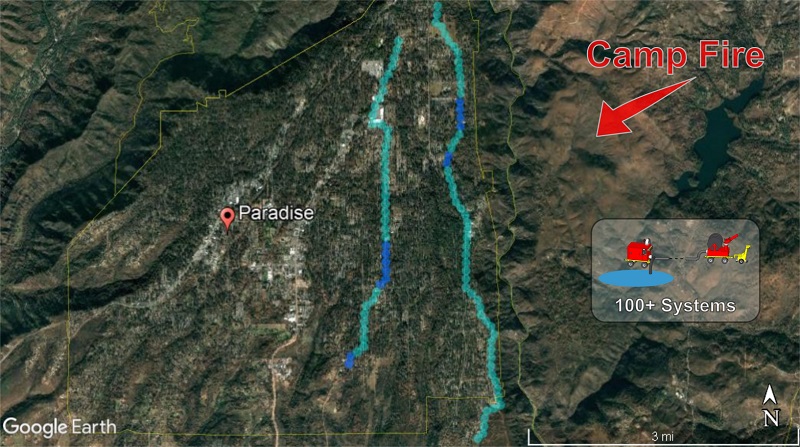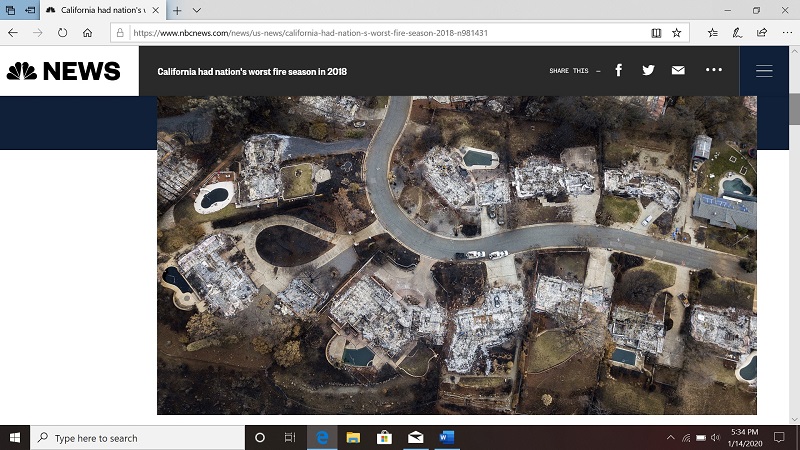This page is provided to show the massive potential of this new Pool Throwing Unit (PTU) solution compared with the 2018 Camp fire. Though the examples on this page are hypothetical, they do show the game changing possibilities. Of course the actual response would’ve been dependent on a number of variables. The main point is to show this PTU solution would’ve provided firefighters with the ability to get a lot more water on the fire faster.
The Camp fire currently ranks as the #1 most destructive wildfire in California history. This fast moving wildfire destroyed 18,804 structures in and around Paradise, CA.
This news story screenshot image shows a devastated area in west Paradise. It should be pretty obvious that neighborhood fire hydrant networks are not designed to protect homes from these massive wind driven firestorms.
Before reaching this neighborhood, the Camp fire destroyed nearly 10,000 structures. It took less than 2 hours from ignition to reach the eastern edges of Paradise. Was there really anything that could’ve been done? See the Google Satellite image below.

There were approximately 400 swimming pools and 15 waterways spread throughout the city of Paradise. Take notice of the high concentration of pools on the eastern side of town.
Considering the high fire risk, let’s assume the city of Paradise and nearby Oroville each owned at least 30 monitor placement PTU’s pictured below and had plans in place for their use.

Firefighters first had eyes on the Camp fire just after 6:30 AM. At that time they could’ve made the call to deploy these PTU’s from Paradise and Oroville (~ 20 minutes away) to their predetermined locations. A crew of 10 could’ve easily deployed all 60 PTU’s before the fire reached the eastern limits of the city around 8 AM. Considering how dangerous this fire was, these systems could’ve been left unmanned to operate remotely. See the Google Satellite image below.

This line of overlapped circles represents the outputs from these 60 systems deployed at pools and waterways that were available. This wall of water would be approximately 5 miles long, hundreds of feet in the air and capable of producing 96,000 gallons per minute. That’s 1 million gallons of water in just over 10 minutes. For perspective, that’s the equivalent of receiving 1000 Firehawk helicopter water drops in 10+ minutes which is absolutely unreal! You’d need around 500 helicopters to match that pace.
For an additional fire break, more systems arriving from other locations could’ve been deployed. A second wall of water in the center of town could’ve been established where more pools and waterways were available.

This line would provide defense for any continuing fire that jumped the first line. Another 700,000 gallons delivered in about 10 minutes. Again with safety in mind, these systems could’ve been started and operated remotely. These two walls of water would’ve been capable of producing up to 160,000 gallons per minute. Again with a Firehawk comparison, that’s like receiving ~ 3 helicopter drops per second for over 10 straight minutes. You’d need ~ 1000 helicopters to match that pace. Even if you had that many, all aircraft were grounded during this period due to wind and visibility. Pools should not sit full while homes burn.
There are also many examples that can be provided for protecting individual neighborhoods as well. See the Google Satellite image below.

This image shows a zoomed out view of the neighborhood pictured at the top of this page. This shows where 40 expensive homes were destroyed while 25 large pools sat full. That’s around 500,000 gallons of water sitting right where it was needed. If firefighters deployed a system at every pool, they could’ve made it rain in a big way. See the following Google Satellite image.

The area in blue would’ve received the equivalent of ~ .25 inches of rain in just over 13 minutes. That’s 40,000 gallons per minute! No neighborhood hydrant system can come close to this level output. Is there any question that many of these homes could’ve been saved. There are so many other examples like this from the Camp fire.
As with all wildfires, fire crews used all the possible assets for the best possible outcome during the Camp fire. No matter how many firetrucks you have, flow rates are still limited by the water main size feeding the hydrants. These hydrant networks are not designed to defend against massive wildfires. A typical neighborhood will be fed by a 6, 8, 10, or 12 inch main. The maximum flow rates will be capped at approximately 800, 1600, 3000, and 4700 GPM respectively. Again, the examples provided on this page are hypothetical but do show the massive potential of this new PTU solution. Throughout many of the areas of destruction from the Camp fire, it would’ve been possible to create flow rates of 10, 20, 50 and even 100+ times greater than local hydrant networks. Firefighters could’ve literally made it rain!
